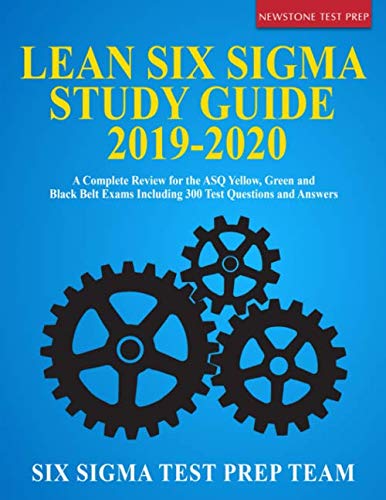Lean Six Sigma Study Guide 2019-2020: A Complete Review for the ASQ Yellow, Green and Black Belt Exams Including 300 Test Questions and Answers / Six Sigma Test Prep Team
| List Price: | |
Our Price: $29.99 | |
|
For Bulk orders
| |
|
Used Book Price: | |
| Lean Six Sigma Study Guide 2019-2020: A Complete Review for the ASQ Yellow, Green and Black Belt Exams Including 300 Test Questions and Answers / Six Sigma Test Prep Team | |
| Publisher: Independently published | |
| Availability:Usually ships in 24 hours | |
| Sales Rank: 67854 | |
|
Similar Books
The exam questions for Yellow, Green and Black Belts have changed as of 2019. While other shorter books have around 60 questions, this guide includes 300 questions so that students are fully prepared before taking the exam.
This guide includes a complete review of theory that students will need to know. Furthermore, questions and answers are divided by Belt Type. The Yellow, Green and Black Belts have 100 questions each, with a total of 300 questions in this book.
Consider the Table of Contents below and you will see that this guide stands out from the rest.
Table of Contents
Chapter 1 – Understanding Six Sigma
Chapter 2 – The Pros and Cons of Six Sigma and How the Cons Are Reversed
Chapter 3 – The Belt Levels of Six Sigma
Chapter 4 – The Five Voices
Chapter 5 – The Eight Dimensions of Quality
Chapter 6 – The DMAIC Steps
Chapter 7 – The DMADV (DFSS) Process
Chapter 8 – Going Lean (Lean Principles)
Chapter 9 – The Most Common Types of Waste
Chapter 10 – Defects vs. Defectives
Chapter 11 – Project Acceptability
Chapter 12 – The Five Key Deliverables of the Define Stage
Chapter 13 – Operating the VOC
Chapter 14 – The Kano Model
Chapter 15 – The Pareto Principle
Chapter 16 – Critical to Quality (CTQ)
Chapter 17 – Creating a Project Charter
Chapter 18 – The Stakeholder Analysis
Chapter 19 – The Change Acceleration Process (CAP)
Chapter 20 – The Value Stream Map
Chapter 21 – Options for Process Mapping
Chapter 22 – The 15 Most Important Details for Planning a Six Sigma Task
Chapter 23 – Designing a Communication Plan
Chapter 24 – The Cost of Quality and the Cost-Benefit Analysis
Chapter 25 – Choosing the Y Between Effectiveness and Efficiency
Chapter 26 – Musts and Wants
Chapter 27 – Brainstorming
Chapter 28 – Identifying and Managing the X and Y
Chapter 29 – Variations in the Measurement System
Chapter 30 – The Sampling Process
Chapter 31 – A General Measurement System
Chapter 32 – Key Factors for Data Interpretation
Chapter 33 – Using the Right Measurement Chart (The Basic Tools of Quality)
Chapter 34 – How Capable Is the Process?
Chapter 35 – Root Cause Analysis
Chapter 36 – Cause Mapping
Chapter 37 – Managing Hand Offs
Chapter 38 – Hypothesis Testing
Chapter 39 – Producing Solution Parameters
Chapter 40 – Generating the Best Possible Solution
Chapter 41 – Calculating the RTY
Chapter 42 – The Failure Mode Effect Analysis
Chapter 43 – Benchmarking
Chapter 44 – Piloting a Six Sigma Solution
Chapter 45 – The Validation of the Measurement System (R&R)
Chapter 46 – New Process Mapping
Chapter 47 – Statistical Process Control
Chapter 48 – Choosing the Right Kind of Control Chart
Chapter 49 – Deming’s Four Rules for Tampering In SPC
Chapter 50 – The Central Limit Theorem
Chapter 51 – The Control Chart and Control Limits
Chapter 52 – Specification Limits
Chapter 53 – Leading and Lagging Indicators (KPIs)
Chapter 54 – Managing All Risks
Chapter 55 – Getting a Control Plan Ready
Chapter 56 – The Gemba Walk
Chapter 57 – Kanban
Chapter 58 – Signing Off of the Six Sigma Task
Chapter 59 – Planning a Six Sigma Presentation
Chapter 60 – Managing Conflicts In the Task
Yellow Belt Questions and Answers
Green Belt Questions and Answers
Black Belt Questions and Answers
For a complete study guide, scroll up and order your copy today.
Now you can buy Books online in USA,UK, India and more than 100 countries.
*Terms and Conditions apply
Disclaimer: All product data on this page belongs to
 .
.No guarantees are made as to accuracy of prices and information.










